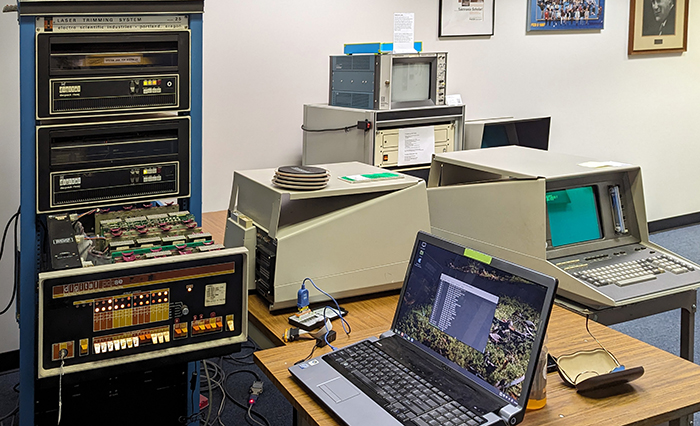DEC PDP-8/E Exhibit
The museum acquired an Electro Scientific Industries PDP-8/E laser trimming system computer used to trim hybrids in the Hybrids Component Organization (HCO) (later becoming Maxtek, and now part of the Tektronix Component Systems Group).
Volunteer Vincent Slyngstad started restoration in 2020 but work stopped when the museum shut down during Covid. He came back and finished the restoration and it is now fully operational. We are very grateful to Vincent for his work and dedication on getting this system running.
This photo shows his test setup which is backing up the RK05 system disk packs. The 4051 is the PDP-8/E console, and his laptop and specialized hardware including new cards for the PDP-8/E is the backup media.
The PDP-8 was first introduced by Digital Equipment Corporation (DEC) in 1965 for $18,000. It is a 12 bit machine addressing 4096 words. It was designed with diode-transistor logic (DTL). The PDP-8/E model was upgraded to faster transistor-transistor logic (TTL) and introduced in 1970 for $6,500. Pete Mackie was responsible for the installation of the first PDP-8 in Tektronix.
This sequence of short videos shows various work on the PDP-8/E in 2020 and 2023.
This video shows the PDP-8/E running memory tests.
We now have this computer running interactive programs displayed on a Tektronix MEG121 19" Storage Display Monitor (in non-store) to demonstrate computing in the 1970s. It includes some graphic games such as Life, Kaleidoscope, and Spacewar! Note the tiny SD memory-based RK05 at the bottom. The MEG 121 display screen is a double exposure to eliminate glare.
We posted this story on the Facebook DEC PDP8 group. Don Baccus posted this reply on the ESI laser trimmers.
Wow a bunch of memories ...
"Pete Mackie was responsible for the installation of the first PDP-8 in Tektronix."
He was a great guy. Got to know him while in high school and learning software development at the Oregon Museum of Science and Industry (OMSI). I believe he was responsible for Tek donating a 4002A storage tube terminal. Later Tek donated some of the more modern ones identical to those in the photo above.
Regarding the ESI laser trimmers, the main PDP-8/E based product ran OS/8 and a custom language for writing programs to trim specific circuits. Much of the development of that interpreter and various support software was written on a PDP-8/E running a kernel that provided several virtual machines, each running OS/8, shared by the software engineers. I wrote the kernel and with an ESI electrical engineer designed and implemented custom memory-mapping hardware based on ideas from Richie Lary of DEC. This mapped CDF instructions in code running in user mode directly rather than causing a trap and interrupt,unless mapped to 0, used to flag fields not in memory, which allowed the implementation of a virtual memory scheme while greatly speeding up code running in user mode. The basic concept was later implemented by EduComp and used in their turnkey multi-user systems sold in the educational market.
The PDP-11 based trimmers came later, and I was co-author of the Pascal compiler that was used to implement the software. This later became known as OMSI Pascal-1, sold by Oregon Software which spun off of the science museum when several of us graduated from college.
This photo of testing PDP-8/E memory is from the DEC Public Relations Department: "On Lline" monthly publication August 1970. It is of Remo Vogelsang and Dick Madden testing DEC PDP-8/E MM8-E memory using a Tektronix Type 547 oscilloscope. Tektronix oscilloscopes were used to design the PDP-8/E and it was used to design Tektronix oscilloscopes.



